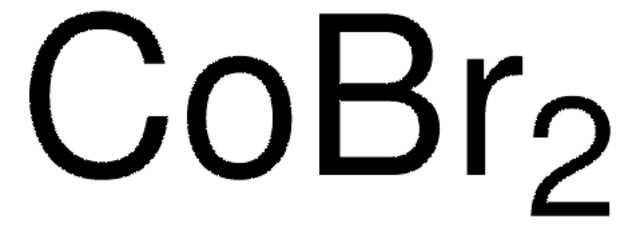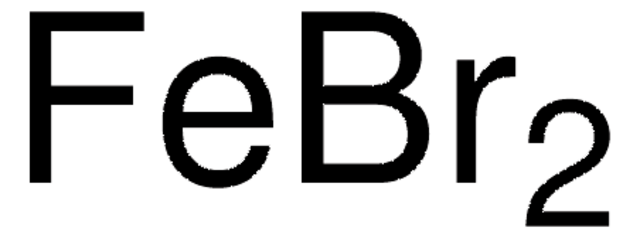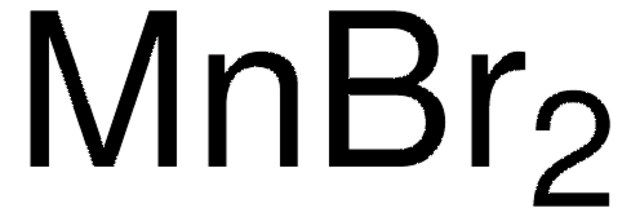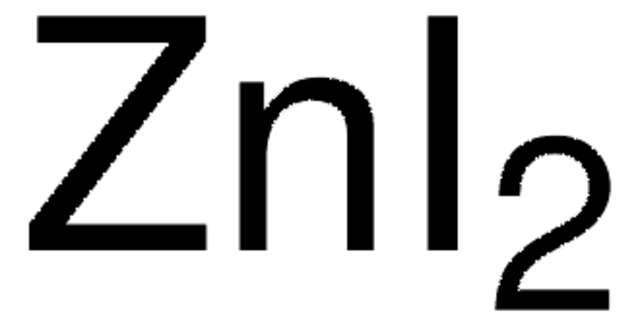334022
Cobalt(II) bromide
99%
Synonyme(s) :
Cobaltous bromide, Dibromocobalt
About This Item
Produits recommandés
Qualité
for analytical purposes
Niveau de qualité
Essai
99%
Forme
powder
Pf
678 °C (lit.)
Solubilité
acetone: soluble(lit.)
ethanol: soluble(lit.)
methanol: soluble(lit.)
Densité
4.909 g/mL at 25 °C (lit.)
Application(s)
battery manufacturing
Chaîne SMILES
Br[Co]Br
InChI
1S/2BrH.Co/h2*1H;/q;;+2/p-2
Clé InChI
BZRRQSJJPUGBAA-UHFFFAOYSA-L
Vous recherchez des produits similaires ? Visite Guide de comparaison des produits
Application
- Synthesis, crystal structure and thermal properties of dibromidobis (2-methylpyridine N-oxide-κO) cobalt (II): This study provides insights into the crystal structure and thermal properties of a cobalt(II) bromide complex, highlighting its potential applications in materials science (Näther & Jess, 2024).
- Coordination complexes of isoquinoline with cobalt and nickel halides: The study describes the formation of coordination complexes using cobalt(II) bromide with isoquinoline, which could be used for further exploration in coordination chemistry (Bellerive et al., 2024).
Mention d'avertissement
Danger
Mentions de danger
Conseils de prudence
Classification des risques
Acute Tox. 4 Oral - Aquatic Acute 1 - Aquatic Chronic 1 - Carc. 1B - Muta. 2 - Resp. Sens. 1 - Skin Sens. 1
Code de la classe de stockage
6.1C - Combustible acute toxic Cat.3 / toxic compounds or compounds which causing chronic effects
Classe de danger pour l'eau (WGK)
WGK 3
Point d'éclair (°F)
Not applicable
Point d'éclair (°C)
Not applicable
Faites votre choix parmi les versions les plus récentes :
Déjà en possession de ce produit ?
Retrouvez la documentation relative aux produits que vous avez récemment achetés dans la Bibliothèque de documents.
Les clients ont également consulté
Articles
Lithium-ion batteries represent a group of electrochemical devices used for electricity storage and have attracted a lot of attention in the past two decades due to their portability, rechargeability and low cost.
We presents an article about a micro review of reversible addition/fragmentation chain transfer (RAFT) polymerization. RAFT (Reversible Addition/Fragmentation Chain Transfer) polymerization is a reversible deactivation radical polymerization (RDRP) and one of the more versatile methods for providing living characteristics to radical polymerization.
Tools for Performing ATRP
Applying ARGET ATRP to the Growth of Polymer Brush Thin Films by Surface-initiated Polymerization
Protocoles
We present an article about RAFT, or Reversible Addition/Fragmentation Chain Transfer, which is a form of living radical polymerization.
We presents an article featuring procedures that describe polymerization of methyl methacrylate and vinyl acetate homopolymers and a block copolymer as performed by researchers at CSIRO.
An article about the typical procedures for polymerizing via ATRP, which demonstrates that in the following two procedures describe two ATRP polymerization reactions as performed by Prof. Dave Hadddleton′s research group at the University of Warwick.
Global Trade Item Number
| Référence | GTIN |
|---|---|
| 334022-250G | 4061838138972 |
| 334022-50G | 4061826737729 |
Notre équipe de scientifiques dispose d'une expérience dans tous les secteurs de la recherche, notamment en sciences de la vie, science des matériaux, synthèse chimique, chromatographie, analyse et dans de nombreux autres domaines..
Contacter notre Service technique














